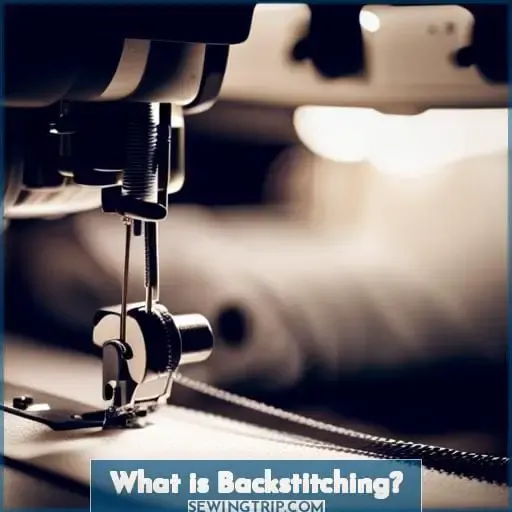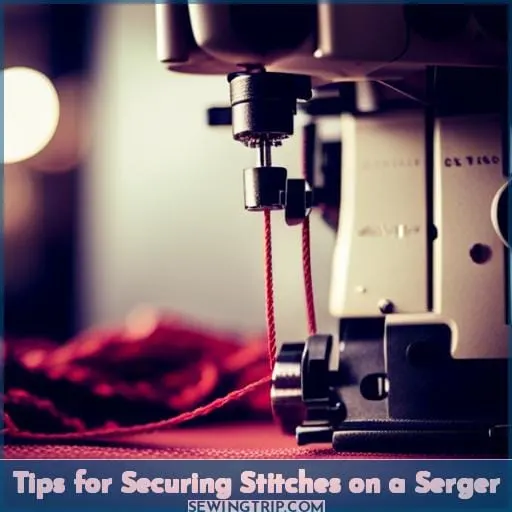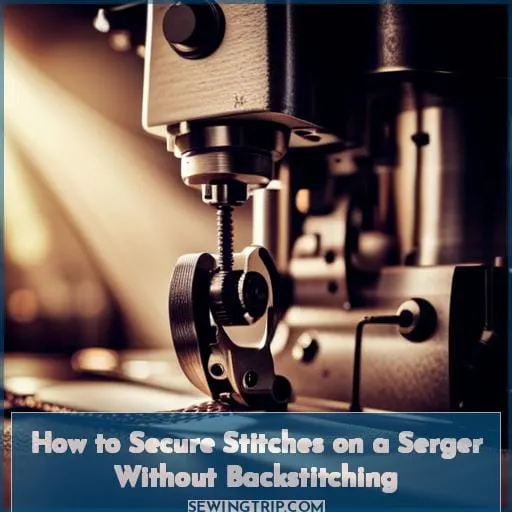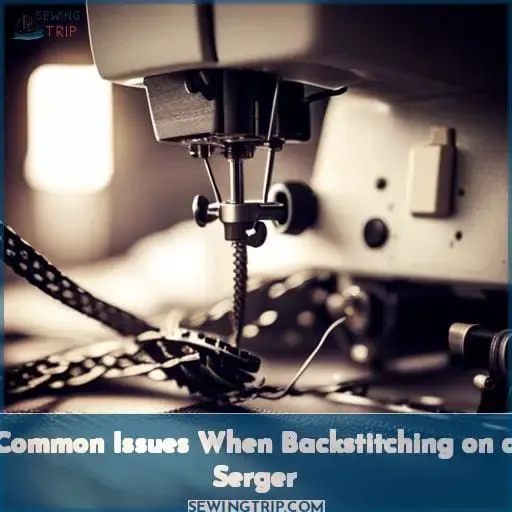This site is supported by our readers. We may earn a commission, at no cost to you, if you purchase through links.
 Discover the power and versatility of your serger as you explore the question: Can You Backstitch on a Serger? Unleash your sewing skills and master new techniques with this informative article.
Discover the power and versatility of your serger as you explore the question: Can You Backstitch on a Serger? Unleash your sewing skills and master new techniques with this informative article.
Learn about the differences between a serger and a sewing machine, discover how to use the reverse function on your serger, and find alternative methods for securing stitches.
Table Of Contents
Key Takeaways
- Backstitching is not possible on a serger.
- Alternative methods for securing stitches on a serger include knotting the serger chain, weaving the serger chain into the seam, using a serger sealant, and tying a knot at the end of the stitch line.
- Common issues when backstitching on a serger include uneven stitches, thread breakage, skipped stitches, and uneven tension.
- Understanding the differences between a serger and a sewing machine, utilizing the reverse function on a serger, and exploring alternative stitching techniques are key to ensuring the durability of seams on a serger.
What is Backstitching?
Backstitching is a sewing technique that involves stitching backwards and forwards over the same line of stitches to secure them in place.
- Reinforcing seams
- Preventing unraveling
- Providing extra strength to your sewing projects
Backstitching is commonly used on a regular sewing machine by simply reversing the direction of the stitch or using the backstitch button. However, it can be more challenging to achieve on a serger due to its different functions and stitches.
While some sergers have a built-in backstitch feature, others may require alternative methods such as locking stitches or hand backstitching for securing seams effectively.
When working with knits on a serger, it’s essential to use techniques like chain off stitching or using stretchy threads instead of traditional backstitches for better results.
Why is Backstitching Important in Sewing?
Backstitching is an essential technique in sewing that reinforces stitches and prevents them from unraveling. It holds your stitches in place, locks seams securely, and prevents gaps or holes from forming.
When you backstitch, you’re essentially doubling up on the stitching at the beginning and end of a seam to reinforce it.
Backstitching also helps to reinforce edges, such as hems or cuffs, where there may be more tension applied to the fabric. By creating a double knot with each stitch during backstitching, you create extra security for your projects.
In addition to preventing unraveling and reinforcing stitches on a regular sewing machine, backstitching can also be done on some serger machines by adjusting settings or using specific techniques like stay stitching or tying thread tails together before trimming them off neatly.
Can You Backstitch on a Serger?
So, you’re wondering if you can backstitch on a serger? Well, the answer is no. Unlike a sewing machine which has a reverse function to create secure stitches at the beginning and end of seams, a serger doesn’t have this feature.
However, there are alternative methods for securing stitches on a serger that we’ll explore in more detail.
Differences Between a Serger and a Sewing Machine
When using a serger, it’s important to understand the differences between a serger and a sewing machine in order to determine whether backstitching is possible.
- A serger creates overlock stitches while a sewing machine creates lockstitches or zigzag stitches.
- Sergers can trim fabric edges while sewing machines don’t have this feature.
- Sewing machines have a reverse function for backstitching, but most sergers do not.
Understanding these differences will help you find alternative methods for securing your stitches on a serger without traditional backstitching techniques.
[ADDITIONAL INFORMATION]
Using the Reverse Function on a Serger
To secure your stitches on a serger, you can utilize the reverse function by sewing in the opposite direction. This is especially useful when you reach the end of a serger seam and need to lock it in place.
Simply lift the presser foot, flip the fabric over, and engage the reverse function to sew back for an inch or two. This will create a secure backstitch at the end of your seam on your serger machine model.
Alternative Methods for Securing Stitches on a Serger
If you want to secure your stitches on a serger without backstitching, there are alternative methods you can use:
- Knotting the serger chain
- Weaving the serger chain into the seam
- Using a serger sealant
These methods provide a secure finish for your stitches and prevent unraveling. They’re especially useful when working with stretch fabrics or when you prefer not to have visible knots or short stitches.
Tips for Securing Stitches on a Serger
Ensure the durability of your serger stitches by implementing these helpful tips for securing them:
- Knot the thread: Tie a double knot at the end of your stitch line to prevent unraveling.
- Use seam sealant: Apply a seam sealant on the thread chain to keep it in place and prevent fraying.
- Weave the chain: Take a tapestry needle and weave the thread chain back into your stitching for added security.
By following these tips, you can ensure that your serger stitches stay intact and withstand everyday wear. Whether you choose to knot, use seam sealant, or weave the chain, each method provides its own level of strength and stability.
Experiment with different techniques until you find one that works best for you. With proper secure stitching, you can confidently create professional-looking garments that will stand up to any challenge.
How to Secure Stitches on a Serger Without Backstitching
Now that you’re familiar with some helpful tips for securing stitches on a serger, let’s explore how to achieve the same level of security without relying on backstitching.
- Knot the thread tail:
- Tie a knot as close to the edge as possible, ensuring that it’s secure enough to prevent unraveling.
- Apply seam sealant:
- Snip the thread tail close to the edge and add a small amount of fray block or fray check for added reinforcement.
- Weave the chain:
- Chain off several inches of stitches and use a tapestry needle to carefully weave the chain back into itself, creating a seamless finish.
- Serge in the opposite direction:
- Lift your presser foot at end of fabric edge and gently flip it over onto its other side before continuing serging in reverse for an inch or two.
Common Issues When Backstitching on a Serger
When backstitching on a serger, you may encounter some common issues that can affect the quality of your stitches.
- Uneven stitches can occur due to incorrect thread tension or an issue with the machine’s settings.
- If your thread breaks frequently while backstitching, check for any tangled threads or knots in the needle area and rethread if necessary.
- Another problem that may arise is when the blade catches threads from previous stitching lines, which can lead to messy and inconsistent stitches.
- Additionally, fabric puckering can be caused by using too tight of a stitch setting or not using a ballpoint needle suitable for knit fabrics.
To avoid these issues altogether, consider alternative methods like securing with woven bias tape hem finish instead of relying solely on backstitching when working with delicate fabrics or intricate designs.
Frequently Asked Questions (FAQs)
Can backstitching be used to secure stitches on a serger?
Backstitching isn’t typically used to secure stitches on a serger. Instead, you can use other methods like:
- Knotting the threads
- Applying seam sealant
- Weaving the chain back into the stitching for a secure finish.
What are some alternatives to backstitching for securing stitches on a serger?
To secure stitches on a serger without backstitching, try these alternatives:
- Knotting the threads for a discreet finish.
- Threading the chain ends through the stitch itself.
- Securing the tail as you begin sewing.
Get creative and master your serging techniques!
Are there any specific techniques or tips for securing stitches on a serger without backstitching?
To secure stitches on a serger without backstitching, try:
- Knotting the threads
- Applying seam sealant
- Threading the chain ends through the stitch itself
- Securing the tail as you begin sewing.
Experiment and find what works best for your project!
What are the common issues that can arise when attempting to backstitch on a serger?
When attempting to backstitch on a serger, common issues can arise such as:
- Thread breakage
- Skipped stitches
- Uneven tension
It’s important to understand the limitations of your machine and explore alternative methods for securing stitches.
Is backstitching necessary for all types of sewing projects on a serger?
Backstitching on a serger isn’t necessary for all sewing projects.
For example, when creating decorative edges or finishing seams that won’t be subjected to high stress, backstitching may not be needed.
Conclusion
To conclude, the power and versatility of your serger can be harnessed to secure stitches without the need for traditional backstitching.
While backstitching may not be possible on a serger, there are alternative methods for ensuring the durability of your seams.
By understanding the differences between a serger and a sewing machine, utilizing the reverse function on your serger, and exploring alternative stitching techniques, you can confidently tackle any project with your serger.
So go ahead, unleash your sewing skills and take charge of your creations!











